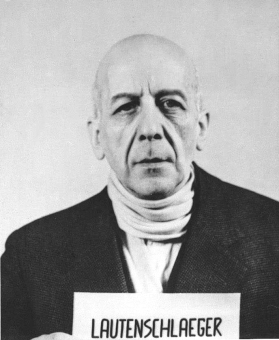Carl-Ludwig Lautenschläger (1888–1962)

© National Archives, Washington, DC
“When I was designated as plant manager of Hoechst by the I.G.’s managing board and supervisory board in 1938, the Gauleiter of Hessen-Nassau, Sprenger, informed me that he was willing to endorse me only if I joined the NSDAP. After extensive consideration […] I decided to take this step, as no other suitable man for running the plant came into consideration at the time. I had to prevent the Gauleiter from installing as plant manager either a Party member from the plant who was in thrall to him or another colleague from the Gau leadership; this would have been to the great detriment of the plant and the workforce as well.”[1]
Carl-Ludwig Lautenschläger was born in Karlsruhe on February 27, 1888, the son of architect Ludwig Lautenschläger and his wife, Paula (née Schober). He attended school in Karlsruhe and Mannheim and completed an apprenticeship as a pharmacist in Karlsruhe. After that, he studied chemistry, pharmacy, and medicine at universities in Karlsruhe, Heidelberg, Würzburg, and Freiburg, receiving a degree in chemistry in 1910. He received his doctoral degree in engineering in Karlsruhe in 1913. After one year of military service, he was awarded his pharmacist’s license in 1915, and he then resumed his medical studies. In 1919, he passed the state examination for physicians and received his M.D. degree in Freiburg. In July of the same year, he qualified as a professor of the pharmaceutical sciences. In 1920, he became a non-tenured professor of pharmacy at the University of Greifswald.
That same year, Carl-Ludwig Lautenschläger joined the pharmaceutical department of Hoechst AG, where he was promoted to chief of the Science Office in 1922 and was made an authorized signatory. He did research primarily in the field of antidiabetic drugs. In 1931, he was named an alternate member of the managing board of I.G. Farben and a member of the Pharmaceutical Main Assembly. He was responsible in particular for the development and production of vaccines and pest control agents. He was married to Elisabeth Wasmer, with whom he had two children. Lautenschläger joined the NSDAP in 1938, took over the management of I.G. Farben’s Middle Rhine/Main River District (Mittelrhein/Maingau) Operating Unit and the plant in Höchst, and simultaneously became a full member of the managing board. In 1942, he was appointed a “military economy leader” (Wehrwirtschaftsführer), and he was awarded the War Merit Cross 1st Class.
Carl-Ludwig Lautenschläger was arrested by the U.S. military government in 1946, and one year later he was charged with enslavement and mass murder in the I.G. Farben Trial at Nuremberg, but was acquitted in 1948; though the court was convinced that the pharmaceutical department had conveyed to the SS medications to be tested on prisoners, no individual guilt on Lautenschläger’s part could be proven
(SP; transl. KL)
















